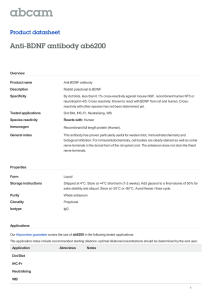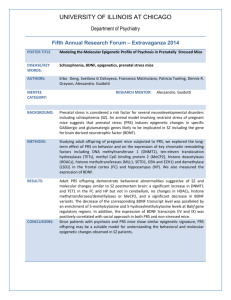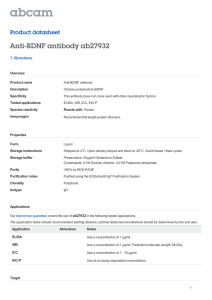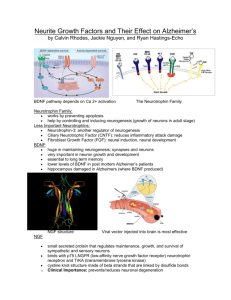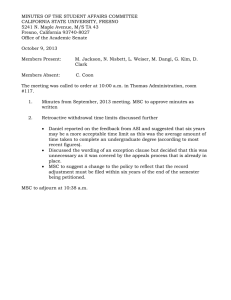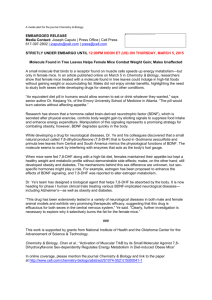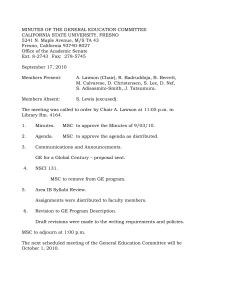Preparing for a Stem Cell-Based Treatment for HD: PRE-CELL and Beyond
advertisement
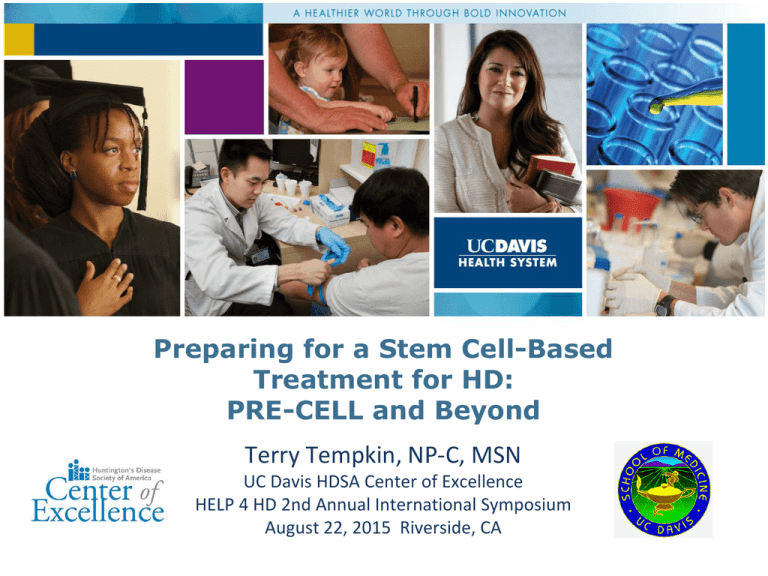
Preparing for a Stem Cell-Based Treatment for HD: PRE-CELL and Beyond Terry Tempkin, NP-C, MSN UC Davis HDSA Center of Excellence HELP 4 HD 2nd Annual International Symposium August 22, 2015 Riverside, CA Disclosures • Teresa Tempkin: – Speaker Bureau: Lundbeck Pharmaceuticals – Roberson and Pue Foundations – California Institute for Regenerative Medicine – None of the above entities have provided any support for my participation here today Huntington’s Disease Slowly progressive, hereditary, degenerative, fatal neuropsychiatric disease Estimated prevalence in US: 30,000 people with HD 150,000 at-risk 2000 new cases annually Estimated costs in US: $2.5 billion Symptoms: Involuntary movements, loss of cognition, psychiatric disorders No disease-modifying therapies exist. All clinical care is palliative Woody Guthrie, 1943 Huntington gene discovered in 1993 HTT gene htt protein Normal number: < 31 CAG “Gray area”: 32-38 CAG Huntington disease: > 38 CAG HD Collaborative Research Group. Cell 1983:72; 971–983. Population affected by HD Location Total Population People with HD* People at risk** Total affected and at-risk Impacted family members*** California 37,253,956 3,725 25,146 28,871 92,676 United States 308,745,538 30,874 208,403 239,277 768,079 (Adapted to US Census, 2010) * Estimated, based on NIH quoted prevalence of 1/10,000 ** Estimated based on 2000 estimate of 200,000 at risk = 6.75/10,000 *** Estimated number of household members impacted by HD based on average family unit of 3.21 members Source: HDSA, 04/2010 Neuropathological findings in HD Control Late HD Stage 1 2 3 Medium spiny striatal neurons affected Progressive neuronal loss in dorsal-medial to ventrolateral direction At death, brain weight is reduced by 25% Striatum is reduced by 90% Deep cortical layers and white matter also strikingly reduced Reiner A et al. Int Rev Neurobiol. 2011;98:325-72 4 Symptoms and Brain Degeneration in HD Impulsivity Chorea: involuntary movements Balance problems Multi-tasking Creativity Slow eye movements Restless, fidgets Episodic anger Irritability Slowness of movement Depression, anxiety Striatum Unaffected Trouble swallowing Advanced HD OCD Psychosis Organizing Concentrating Prioritizing Fine motor tasks Compelling Reasons for Developing Cell Therapies in HD • The disease is always fatal in people who carry the gene expansion. • To date there is no medication or therapy that will delay the onset or slow the progression of the disease • The gene is passed on to future generations. • An effective treatment or cure may have indications for use in other polyglutamate expansion diseases such as SCAs. • • • • 2004: California voters passed Proposition 71, the California Stem Cell Research and Cures Initiative. 2005: The California Institute for Regenerative Medicine established The mission of CIRM is to support and advance stem cell research and regenerative medicine under the highest ethical and medical standards for the discovery and development of cures, therapies, diagnostics and research technologies to relieve human suffering from chronic disease and injury. CIRM is the largest source of funding for embryonic and pluripotent stem cell research in the world. From Dr. Jan Nolta Unique Opportunity: • The HDSA Center of Excellence at UC Davis, designated in 2001, provides multidisciplinary care for over 350 HD patients and families. • Through membership in the Huntington Study Group, we have enrolled over 325 patients in more than 14 observational studies and clinical trials since 1997. • Despite extensive knowledge of the genetics and neuropathology of HD, only palliative treatments exist, constituting a major unmet need. • Translational partnership developed with Dr. Nolta’s team in 2008 to promote research in HD, leading to a CIRM Translational grant in 2009 and Disease Team grant in 2012. Translational Team Effort The grant is approved! July 26, 2012 What are you really doing? • • • • • Medium spiny neurons (cells in the brain) die out in HD (causing HD symptoms) Levels of Brain Derived Neurotrophic Factors (BDNF - think ‘fertilizer’ for your brain cells) are lower in people with HD Wouldn’t it be great if we could slow the rate at which those cells die off and increase levels of BDNF to keep the neurons healthy longer? And wouldn’t it be great if we could develop this as a safe ‘treatment’ for HD while we continue to work on a therapy for a cure? And wouldn’t it be better yet if we found that using MSCs would be a safe and reliable method of delivering potential therapies for the treatment and ultimately cure for HD? BDNF: A Lead Candidate for HD Treatment •Survival and function of striatal neurons is dependent on brainderived neurotrophic factor (BDNF). •Mutant huntingtin protein blocks production of BDNF at the RNA level and reduces axonal transport from the cortical cells to the striatum. Levels of this trophic factor are significantly reduced in the brains of HD patients. •Dey et al showed that MSCs engineered to over-express BDNF slowed the progression of HD in a transgenic mouse model. •BDNF delivery triggers the recruitment of new neurons in HD transgenic mouse model. C. Zuccato, M. Valenza, E. Cattaneo, Physiol Rev 2010;90:, 905 Dey ND et al. Behav Brain Res 2010;193-2000 Benraiss A. Cell Stem Cell 2013;787-799 MSCs: a Candidate for Delivery of BDNF • MSCs secrete neurotrophic factors, reduce inflammation, reduce programmed cell death, enhance connections between neurons and reduce cell toxicity • MSCs can be readily engineered using viral vectors to robustly deliver growth factors • Vectors do not integrate into host cells • MSCs do not require immunosuppression • Unlike embryonic or pluripotent stem cells, MSCs have a strong safety profile in clinical trials • 43 published, peer reviewed proof of concept studies have demonstrated efficacy for MSC, BDNF, or MSC/BDNF in HD mouse models (Reviewed in Deng et al, in press 2015) Project Plan: MSC/BDNF for HD CIRM Grant DR2A-05415 PRE-CELL: Years 1&2 Preclinical (on-going) Clinical HD-CELL: Years 3&4 Jan Nolta, PhD PI 15-01 Pre-Clinical Lead HD Disease Team UCD JJJan Vicki Wheelock, MD, PI PRE-CELL and DR2A-95415, JJJan Clinical Lead Charles DeCarli, clinical co-PI Geralyn Annett, CLS Project Manager Gerhard Bauer CMC Lead and staff UCD GMP facility JJJan Product certification (outsourced) Jon Walker, CLS, QA/QC Lead Kari Pollock, Study director, Kyle Fink, Ph.D. JJJan and staff Pharm/tox – rodent studies Clinical Pathology JJJan Lab (CPL), UC Davis William Gruenloh, UC Davis JJJan IND preparation Regulatory oversight, Teresa Tempkin RN MSN Clinical Project Manager JJJan Alexandra Duffy, DO Co-investigator , Neurorestorative Therapeutics Team Kia Shalaie, MD, PhD Lead Neurosurgeon, JJJan UC Davis, Dan Lim, MD, PhD - UCSF Scher-Psychiatrist, Farias-Neuropsychology, DeCarli-Imaging, Yarborough-Bioethics, JJJan Martin-Clinical trial Mooney-Social Worker, coordinator; Stout–Cognitive Assessments, Hersch – Biomarkers, Li-Biostatistician CRO JJJan data management/ Clinical trial oversight and Medical monitor preClinical Studies • These are experiments that are required to be done prior to receiving approval from the FDA (government entity that is responsible for approving any new drug, medical treatment or device in the US) • FDA approval can be arduous, but necessary to safeguard people in human trials • Only after the FDA is satisfied that all reasonable safety measures have been met, will they give you ‘permission’ to try in humans BDNF production by the engineered MSCs BDNF Production: hMSC pCCLc-MNDU3-BDNF-WPRE 25000.0 BDNF (pg/200k cells/24hrs) 20000.0 15000.0 10000.0 5000.0 0.0 WT MOI 2 MOI 5 MOI 10 MOI 20 BDNF Production: Human MSCs were transduced with the lentiviral vector pCCLc-MNDU3-BDNF-WPRE at the indicated Multiplicity of infection (MOI). Increasing the MOI increases the amount of BDNF produced. 21 HD Transgenic Mouse Models • We used the YAC128 and R6/2 (120) strains of mice as models of HD and Juvenile HD – The YAC128 mouse has late onset, mild symptoms, and striatal atrophy – The R6/2 (120) mouse has early onset and seizures, and very early death (approx. 90 days) • Mice were immune suppressed to permit survival of human cells • Mice were transplanted with 500,000 human MSC or MSC/BDNF in the brain Pre-clinical Summary: YAC128 model • Mice treated with MSC/BDNF had significantly greater exploratory behaviors in open field testing compared to controls, indicating a behavioral measure of reduced anxiety. • Mice treated with MSC and MSC/BDNF had reduction in the degree of striatal atrophy compared to control mice. • We have demonstrated both a behavioral and a structural improvement due to treatment in the YAC128 model. R6/2 Neurogenesis: 2014-0825 Efficacy study Doublecortin Average Fluorescent Intensity 18 16 14 *# * 12 10 8 6 4 2 0 Tg + MSC BDNF MOI 10 Tg + Normosol Tg + MSC WT + Normosol * = Significant to WT, # = Significant to tg + Normosol. Transplantation of MSC with and without BDNF significantly increases neurogenesis activity in the subventricular zone. Pre-clinical Summary: R6/2 (CAG 120) model • Mice treated with MSC or MSC/BDNF have a significant increase in neurogenesis-like activity in the subventricular zone compared to controls. • These data suggest that MSC/BDNF could work through mechanisms of stimulating endogenous neurogenesis. • Striatal implantation of MSC/BDNF increased the mean lifespan of the R6/2 (CAG 120) mice. • Increasing neurogenesis and striatal neuron survival is a key goal of the planned future clinical trial, HD-CELL. Pre-clinical Summary • Taken together our results demonstrate that MSC/BDNF reduced anxiety, slowed down or prevented striatal atrophy, and increased the lifespan when using two different transgenic mouse models of HD. • This recovery may be due to the stimulation and maturation of endogenous neurogenesis promoted by the MSC and enhanced by BDNF. Clinical Trials PRE-CELL: We have enrolled 31 patients with early-stage HD. We are collecting clinical data (neurological and psychiatric exams, functional abilities, cognitive evaluation, volumetric brain MRI, and exploratory serum and CSF biomarker studies) with assessments every 6 months. We are determining the rate of change in each parameter for every subject in order to enhance safety and permit exploratory measures of clinical efficacy and biomarkers in the planned Phase 1 trial. HD-CELL: We propose to enroll eligible PRE-CELL subjects who have completed at least one year of longitudinal assessments into HD-CELL. This will be an open-label Phase I dose-escalation trial, and all subjects to be treated will receive intrastriatal implantation of MSC/BDNF. PRE-CELL Inclusion Criteria 1. Men or women age 18 and older, English speaking, able to give informed consent and comply with study procedures. 2. HD diagnosis confirmed with genetic testing. 3. Early stage HD with Total Functional Capacity (TFC) score of 9-13. 4. Clinically definite signs of HD. 5. Must have a caregiver or informant able to give feedback about the participant and willing to report observations about subject on standardized forms. 6. Subjects of child bearing potential must agree to adequate birth control measures. Please see http://clinicaltrials.gov/show/NCT01937923 PRE-CELL Recruitment and Enrollment (August 2015) Currently Screened Enrolled 41 30 Excluded/ Pending Withdrawn enrollment 11 0* Scheduled for screening 0* Number of subjects completing scheduled visits Screened Baseline 41 32 V01 (6 mo) 25 V02 (12 mo) 17 V03 (18 mo) 7 *PRE-CELL enrollment ended June 2015 Cognitive Assessments Sarah Farias, PhD Associate Professor of Neurology, UC Davis Julie Stout, PhD Professor, School of Psychological Sciences Monash University 30 Structural MRI Analysis Charles DeCarli, MD Professor, Department of Neurology Director, IdEA Lab at UC Davis Co-Clinical PI 31 Volumetric MRI Brain Analysis Volumetric analysis showing areas of reduced striatal volume in HD-CELL subjects (areas in blue) Volumetric imaging analysis showing change in brain volumes at 6 months. DeCarli IDeA Lab, UC Davis PRE-CELL Interim Results: estimated trajectories Total Functional Capacity Score Total Motor Score Independence Score Total Problem Behavior Assessment Score PRE-CELL Biomarkers Steven Hersch, MD PhD Professor of Neurology Harvard Medical School BDNF Mutant Huntingtin Protein 34 Ethical considerations regarding a first-in-human stem cell gene therapy trial for Huntington’s disease Kyle Fink, PhD Alexandra Duffy, DO Vicki Wheelock, MD Mark Yarborough, PhD University of California Davis Understanding patient and care partner perspectives • A survey on attitudes and beliefs about participation in this study was added the first of this year. • These observations from participants and their care partners will give us valuable information about their current thoughts and expectations and will assist us in designing the study for the treatment trial (HD-CELL). HD-CELL: Phase 1 safety and tolerability trial of MSC/BDNF neurosurgically implanted into striatum using techniques similar to deep brain stimulator implantation. (DBS has been FDAapproved since 1997). We plan to deliver MSC/BDNF to the striatum under interventional high-field MRI-guidance using the ClearPoint® navigation system for targeting and trajectory planning. Treatment Cohorts • Low dose MSC/BDNF • Medium dose MSC/BDNF • High dose MSC/BDNF Low dose MSC/BDNF DSMB Pause Medium dose MSC/BDNF High dose MSC/BDNF DSMB Pause HD-CELL Schedule of Activities Screening + Pre-op Surgery ( within 30 d V1 - 4 Mo. 1-2 V5 3 mo V6 6 mo V7 9m V8 12 m 15 - 24 m X X X X X X X X X X X X X X X X X X X X X X X X X X X X X X X Informed consent X Incl/excl X General exam X Neuro exam X UHDRS X Safety labs X Cognitive battery X X X X X X X Mood /behavior X X X X X X X X X X X X X X X X X X X X X X X X X X X X X X X X X X X X X Functional/ QOL/CGI MRI X Biomarkers X X Lumbar puncture AE X X X Making Progress Toward FDA Approval • May 2015: Completion of pre Investigational New Drug (preIND) application to FDA • June 2015: Recombinant DNA Advisory Committee (RAC) – received valuable recommendations from this mandatory committee with no reservations • July 2015: preIND call with FDA Continue study visits in PRE-CELL • Q2-3 2016: IND application to FDA Final Points for PRE-CELL/HD-CELL….. • If approved, this will be a first-in-human trial of gene therapy-engineered mesenchymal stem cells implanted into the brains of patients with Huntington’s disease • We will primarily measure safety and tolerability of the stem cell treatment • We still have much to learn……. Great Work Inspires Additional Great Work • Because of this ground breaking work in cellular treatment for HD, Dr. Nolta was able to recruit a promising young scientist, Dr. Kyle Fink. • In addition to his work on this project, he has successfully obtained funding to investigate methods for gene modification in Juvenile Huntington’s Disease Transcription activator-like effectors (TALES) • Can be rapidly synthesized to target any base pair sequence • Highly efficient and specific with minimal off-target effects • Can be constructed with a variety of transcription factors (i.e., nucleases, activators, repressors) Thank you HD patients and families! Patients Community Clinic Education Patient Advocate Power Industry Regulatory Source: Katie Jackson, Help4HD Science Chin-Shang Li My sincere thanks to this Executive Team for their expertise and tireless commitment to making a better future for people with HD!


